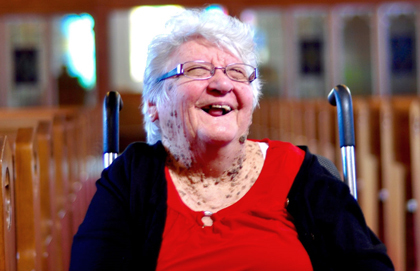Inspired by Faith in Canada’s Thread of 1000 Stories initiative and in response to the “Our Story” focus, students at Niagara Christian Collegiate were invited to participate in a visual storytelling project. The goal was to create a mosaic of story tiles to represent that each individual plays a role in the NCC story and in God’s larger redemptive narrative. Through simple words and images, students were asked to share their understanding of how faith has shaped their stories.
As part of an introductory lesson on short stories, I asked my English students at Niagara Christian Collegiate (NCC), “What makes a good story?” After discussing character development, plot devices, and narration, we agreed that although important to a story, these are simply the devices an author uses to communicate the truth of the story. And a truly good story is one that invites the reader to take this truth beyond the page; the power of a good story lies in its ability to make the reader a participant because it has something to say to or about humanity.
Jesus knew something about the power of good stories: He used them to connect with, challenge, and captivate his diverse audiences. He told stories to communicate spiritual truths while touching personal needs. He had a captive audience in those “hungering and thirsting for righteousness” and used stories in his ministry to “seek and save the lost”.

As host to students from 18 different countries, Niagara Christian Collegiate reflects the cultural and religious diversity that is Canada and, as it turns out, the school celebrates its 85th birthday as Canada turns 150. So, how does a community with faith roots so deep and cultural roots so wide reach a shared understanding of truth? Through the power of story, of course!
The potential of story to communicate the truth of God’s redeeming love fuelled this year’s “Our Story” chapel theme at NCC. Storytellers within and close to the NCC community shared stories of sacrifice, adoption, hope, sorrow and brokenness, miracles, courage, restoration, healing, growth, discipleship, and calling. Each story was as unique as the person telling it, but the same faith message resonated through the collection: My story is better with Jesus because he is “the way, the truth, and the life.” Jesus is the living sacrifice who brings hope, restores the broken-hearted, works miracles, and gives our lives purpose.
But just as some of Jesus’ listeners did not have ears that were ready to hear the truth of a sinful human race in need of a saviour, some NCC students are wrestling with their identities as Christ-followers, others struggling with their understanding of who Jesus is, many asking, “What is faith, and if I have one, in who or what?” Even if they have not found or recognized Christ’s truth in the stories they’ve heard, maybe they will hear echoes of it in their own stories. If they can be encouraged to seek truth rather than being ambivalent towards faith, then the hope is that they will find, in reflecting on their own stories, that God was there the whole time – designing, guiding, and purposing all things to reflect the Truth of Jesus Christ that is redemption’s story.






